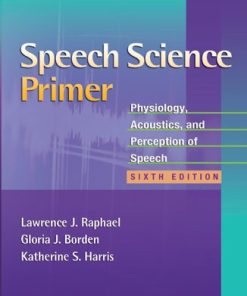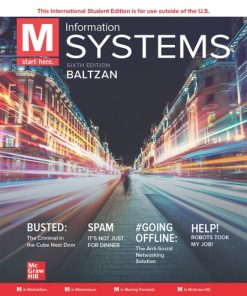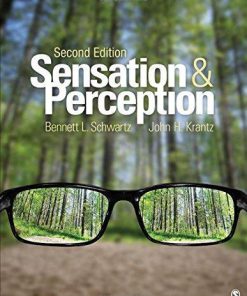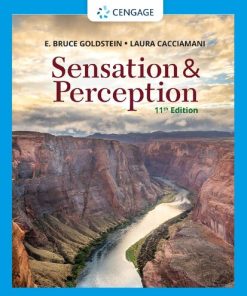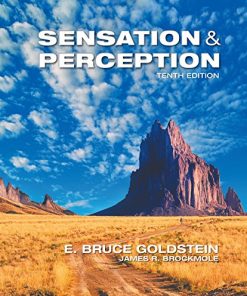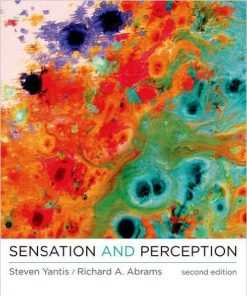(EBook PDF) Sensation and Perception 6th Edition by Jeremy Wolfe, Keith Kluender, Dennis Levi, Linda Bartoshuk, Rachel Herz, Roberta Klatzky, Daniel Merfeld 0197542700 9780197542705 full chapters
$50.00 Original price was: $50.00.$25.00Current price is: $25.00.
Sensation & Perception 6th Edition by Jeremy M. Wolfe, Keith R. Kluender, Dennis M. Levi, Linda M. Bartoshuk, Rachel S. Herz, Roberta L. Klatzky, Daniel M. Merfeld – Ebook PDF Instant Download/DeliveryISBN: 0197542700, 9780197542705
Full download Sensation & Perception 6th Edition after payment
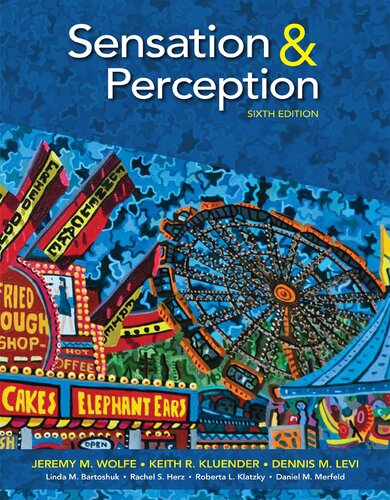
Product details:
ISBN-10 : 0197542700
ISBN-13 : 9780197542705
Author: Jeremy M. Wolfe, Keith R. Kluender, Dennis M. Levi, Linda M. Bartoshuk, Rachel S. Herz, Roberta L. Klatzky, Daniel M. Merfeld
Sensation & Perception, Sixth Edition, introduces students to their own senses, emphasizing human sensory and perceptual experience and the basic neuroscientific underpinnings of that experience. The authors, specialists in their respective domains, strive to spread their enthusiasm for fundamental questions about the human senses and the impact that answers to those questions can have on medical and societal issues.This edition of Sensation and Perception offers an enhanced e-book that includes learning objectives, self-assessment, and a robust, hands-on media package that is designed to engage students through demonstrations, simulations, and activities.
Sensation & Perception 6th Table of contents:
Chapter 1 Introduction
Questions to Contemplate
1.1 Sensation & Perception: Welcome to Our World
METHOD 1: THRESHOLDS
METHOD 2: SCALING—MEASURING PRIVATE EXPERIENCE
METHOD 3: SIGNAL DETECTION THEORY—MEASURING DIFFICULT DECISIONS
METHOD 4: SENSORY NEUROSCIENCE
METHOD 5: NEUROIMAGING—AN IMAGE OF THE MIND
METHOD 6: COMPUTATIONAL MODELS
1.2 Thresholds and the Dawn of Psychophysics
Psychophysical Methods
Scaling Methods
Signal Detection Theory
1.3 Sensory Neuroscience and the Biology of Perception
Nerves and Specific Nerve Energies
Neuronal Connections
Neuronal Firing: The Action Potential
Neuroimaging
1.4 Modeling as a Method: Math and Computation
Computational Models: Probability, Statistics, and Networks
Deep Learning
Summary
List of Key Terms
Chapter 2 The First Steps in Vision: From Light to Neural Signals
Questions to Contemplate
2.1 A Little Light Physics
2.2 Eyes That Capture Light
Focusing Light onto the Retina
The Retina
What the Doctor Saw
Retinal Geography and Function
2.3 Dark and Light Adaptation
Pupil Size
Photopigment Regeneration
The Duplex Retina
Neural Circuitry
2.4 Retinal Information Processing
Light Transduction by Rod and Cone Photoreceptors
Lateral Inhibition through Horizontal and Amacrine Cells
Convergence and Divergence of Information via Bipolar Cells
Communicating to the Brain via Ganglion Cells
CENTER-SURROUND RECEPTIVE FIELDS
P AND M GANGLION CELLS REVISITED
INTRINSICALLY PHOTO SENSITIVE RETINAL GANGLION CELLS (ipRGCs) IN THE DEVELOPING RETINA
Summary
List of Key Terms
Chapter 3 Spatial Vision: From Spots to Stripes
Questions to Contemplate
3.1 Visual Acuity: Oh Say, Can You See?
A Visit to the Eye Doctor
More Types of Visual Acuity
MINIMUM VISIBLE ACUITY
MINIMUM RESOLVABLE ACUITY
MINIMUM RECOGNIZABLE ACUITY
MINIMUM DISCRIMINABLE ACUITY
Acuity for Low-Contrast Stripes
Why Sine Wave Gratings?
3.2 Retinal Ganglion Cells and Stripes
3.3 The Lateral Geniculate Nucleus
3.4 The Striate Cortex
The Topography of the Human Cortex
Some Perceptual Consequences of Cortical Magnification
3.5 Receptive Fields in Striate Cortex
Orientation Selectivity
Other Receptive-Field Properties
Simple and Complex Cells
Further Complications
3.6 Columns and Hypercolumns
3.7 Selective Adaptation: The Psychologist’s Electrode
The Site of Selective Adaptation Effects
Spatial Frequency–Tuned Pattern Analyzers in Human Vision
3.8 The Development of Vision
Development of the Contrast Sensitivity Function
Summary
List of Key Terms
Chapter 4 Perceiving and Recognizing Objects
Questions to Contemplate
4.1 From Simple Lines and Edges to Properties of Objects
4.2 What and Where Pathways
4.3 The Problems of Perceiving and Recognizing Objects
4.4 Mid-Level Vision
Finding Edges
OCCLUSION
RULES OF EVIDENCE
Texture Segmentation and Grouping
CAMOUFLAGE
AMBIGUITY AND PERCEPTUAL “COMMITTEES”
COMMITTEE RULES: HONOR PHYSICS AND AVOID ACCIDENTS
Figure and Ground
A COMPLICATED BUSINESS
Dealing with Occlusion
Parts and Wholes
Summarizing Mid-Level Vision
From Metaphor to Formal Model
4.5 Object Recognition
Can We Build It?
Multiple Recognition Committees?
Faces: An Illustrative Special Case
Summary
List of Key Terms
Chapter 5 The Perception of Color
Questions to Contemplate
5.1 Basic Principles of Color Perception
Three Steps to Color Perception
5.2 Step 1: Color Detection
5.3 Step 2: Color Discrimination
The Principle of Univariance
The Trichromatic Solution
Metamers
The History of Trichromatic Theory
A Brief Digression into Lights, Filters, and Finger Paints
From Retina to Brain: Repackaging the Information
Cone-Opponent Cells in the Retina and LGN
5.4 Step 3: Color Appearance
Three Numbers, Many Colors
The Limits of the Rainbow
Opponent Colors
Color in the Visual Cortex
5.5 Individual Differences in Color Perception
Language and Color
Genetic Differences in Color Vision
Does Everyone See the Same Colors? The Special Case of Synesthesia
5.6 From the Color of Lights to a World of Color
Adaptation and Afterimages
Color Constancy
The Problem with the Illuminant
Physical Constraints Make Constancy Possible
5.7 What Is Color Vision Good For?
Summary
List of Key Terms
Chapter 6 Space Perception and Binocular Vision
Questions to Contemplate
6.1 Monocular Cues to Three-Dimensional Space
Pictorial Depth Cues
Occlusion
Size and Position Cues
Aerial Perspective
Linear Perspective
Seeing Depth in Pictures
6.2 Triangulation Cues to Three-Dimensional Space
Motion Cues
Accommodation and Convergence
6.3 Binocular Vision and Stereopsis
Stereoscopes and Stereograms
Random Dot Stereograms
Using Stereopsis
Stereoscopic Correspondence
The Physiological Basis of Stereopsis and Depth Perception
6.4 Combining Depth Cues
The Bayesian Approach Revisited
Illusions and the Construction of Space
Binocular Rivalry and Suppression
6.5 Development of Binocular Vision and Stereopsis
Abnormal Visual Experience Can Disrupt Binocular Vision
Summary
List of Key Terms
Chapter 7 Attention and Scene Perception
Questions to Contemplate
7.1 Selection in Space
The “Spotlight” of Attention
7.2 Visual Search
Feature Searches Are Efficient
Many Searches Are Inefficient
Guided Searches in the Real World
BASIC FEATURES GUIDE VISUAL SEARCH
HISTORY GUIDES VISUAL SEARCH
PROPERTIES OF SCENES GUIDE VISUAL SEARCH
The Binding Problem in Visual Search
Binding between the Senses
7.3 Attending in Time: RSVP and the Attentional Blink
7.4 The Physiological Basis of Attention
Attention Could Enhance Neural Activity
Attention Could Enhance the Processing of a Specific Type of Stimulus
Attention and Single Cells
Attention May Change the Way Neurons Talk to Each Other
7.5 Disorders of Visual Attention
Neglect
Extinction
7.6 Perceiving and Understanding Scenes
Two Pathways to Scene Perception
The Nonselective Pathway Computes Ensemble Statistics
The Nonselective Pathway Computes Scene Gist and Layout—Very Quickly
Memory for Objects and Scenes Is Amazingly Good
But … Memory for Objects and Scenes Can Be Amazingly Bad: Change Blindness
What Do We Actually See?
Summary
List of Key Terms
Chapter 8 Visual Motion Perception
Questions to Contemplate
8.1 Motion Aftereffects
8.2 Computation of Visual Motion
Apparent Motion
The Correspondence Problem: Viewing through an Aperture
Detection of Global Motion in Area MT
Second-Order Motion
8.3 Using Motion Information
Going with the Flow: Using Motion Information to Navigate
Avoiding Imminent Collision: The Tao of Tau
Something in the Way You Move: Using Motion Information to Identify Objects
Motion-Induced Blindness (MIB)
8.4 Eye Movements
Physiology and Types of Eye Movements
Eye Movements and Reading
Saccadic Suppression and the Comparator
Updating the Neural Mechanisms for Eye Movement Compensation
8.5 Development of Motion Perception
Summary
List of Key Terms
Chapter 9 Hearing: Physiology and Psychoacoustics
Questions to Contemplate
9.1 The Function of Hearing
9.2 What Is Sound?
Basic Qualities of Sound Waves: Frequency and Amplitude
Sine Waves and Complex Sounds
9.3 Basic Structure of the Mammalian Auditory System
Outer Ear
Middle Ear
Inner Ear
COCHLEAR CANALS AND MEMBRANES
THE ORGAN OF CORTI
HAIR CELLS
CODING OF AMPLITUDE AND FREQUENCY IN THE COCHLEA
The Auditory Nerve
BEYOND SIMPLE SOUNDS AT LOW INTENSITY
TWO-TONE SUPPRESSION
RATE SATURATION
TEMPORAL CODE FOR SOUND FREQUENCY
Auditory Brain Structures
9.4 Basic Operating Characteristics of the Auditory System
Intensity and Loudness
Frequency and Pitch
9.5 Hearing Loss
Types of Hearing Loss
Causes of Hearing Loss
Treating Hearing Loss
Using versus Detecting Sound
Summary
List of Key Terms
Chapter 10 Hearing in the Environment
Questions to Contemplate
10.1 Sound Localization
Interaural Time Difference
THE PHYSIOLOGY OF ITDS
Interaural Level Difference
THE PHYSIOLOGY OF ILDS
Cones of Confusion
Pinnae and Head Cues
Auditory Distance Perception
Spatial Hearing and Blindness
10.2 Complex Sounds
Harmonics
Timbre
Attack and Decay
10.3 Auditory Scene Analysis
Spatial, Spectral, and Temporal Segregation
Grouping by Timbre
Grouping by Onset
When Hearing Dominates Vision
When Sounds Become Familiar
10.4 Continuity and Restoration Effects
Restoration of Complex Sounds
10.5 Auditory Attention
Summary
List of Key Terms
Chapter 11 Music and Speech Perception
Questions to Contemplate
11.1 Music
Musical Notes
TONE HEIGHT AND TONE CHROMA
CHORDS
CULTURAL DIFFERENCES
ABSOLUTE PITCH
Making Music
RHYTHM
MELODY DEVELOPMENT
11.2 Speech
Speech Production
RESPIRATION AND PHONATION
ARTICULATION
CLASSIFYING SPEECH SOUNDS
Speech Perception
COARTICULATION AND LACK OF INVARIANCE
CATEGORICAL PERCEPTION
COARTICULATION AND SPECTRAL CONTRAST
USING MULTIPLE ACOUSTIC CUES
Learning to Listen
BECOMING A NATIVE LISTENER
LEARNING WORDS
Speech in the Brain
Summary
List of Key Terms
Chapter 12 Vestibular Sensation
Questions to Contemplate
12.1 Vestibular Contributions
12.2 Evolutionary Development and Vestibular Sensation
12.3 Modalities and Qualities of Spatial Orientation
Sensing Angular Motion (“Rotation”), Linear Motion (“Translation”), and Tilt
Basic Qualities of Spatial Orientation: Amplitude and Direction
AMPLITUDE
DIRECTION
12.4 The Vestibular Organs
Hair Cells: Mechanical Transducers
Semicircular Canals
HOW AMPLITUDE IS CODED IN THE SEMICIRCULAR CANALS
HOW DIRECTION IS CODED IN THE SEMICIRCULAR CANALS
SEMICIRCULAR-CANAL DYNAMICS
WHY SINE WAVE MOTIONS?
Otolith Organs
HOW AMPLITUDE IS CODED IN THE OTOLITH ORGANS
HOW DIRECTION IS CODED IN THE OTOLITH ORGANS
12.5 Spatial Orientation Perception
Rotation Perception
Translation Perception
Tilt Perception
12.6 Multisensory Integration
Visual-Vestibular Multisensory Integration
12.7 Beyond Multisensory Integration: Active Sensing
12.8 Reflexive Vestibular Responses
Vestibulo-Ocular Responses
Vestibulo-Autonomic Responses
Vestibulo-Spinal Responses
12.9 Multisensory Spatial Orientation Cortex
Vestibular Thalamocortical Pathways
Cortical Influences
12.10 When the Vestibular System Goes Bad
Falls and Vestibular Function
Mal de Debarquement Syndrome
Ménière’s Syndrome
Summary
List of Key Terms
Chapter 13 Touch
Questions to Contemplate
13.1 Physical Inputs to Touch
Touch Physiology
Touch Receptors and Neural Fibers
SOMATOSENSORY FIBERS
TACTILE RECEPTORS
KINESTHETIC RECEPTORS
THERMORECEPTORS
NOCICEPTORS
PLEASANT TOUCH RECEPTORS
From Skin to Brain
Pain
MULTIPLE LEVELS OF PAIN
MODERATING PAIN
PAIN SENSITIZATION
Neural Plasticity of Somatosensation
13.2 Tactile Sensitivity and Acuity
How Sensitive Are We to Mechanical Pressure?
How Finely Can We Resolve Spatial Details?
How Finely Can We Resolve Temporal Details?
Do People Differ in Tactile Sensitivity?
13.3 Haptic Perception
Perception for Action
Action for Perception
The What System of Touch: Perceiving Objects and Their Properties
PERCEIVING MATERIAL VERSUS GEOMETRIC PROPERTIES
THE HAPTIC ALGORITHM FOR CURVATURE
HAPTIC SEARCH
PERCEIVING PATTERNS WITH THE SKIN
TACTILE AGNOSIA
The Where System of Touch: Locating Objects
HAPTIC OBJECT LOCALIZATION BEYOND THE BODY
HAPTIC OBJECT LOCALIZATION ON THE BODY
Tactile Spatial Attention
Social Touch
Interactions between Touch and Other Modalities
Summary
List of Key Terms
Chapter 14 Olfaction
Questions to Contemplate
14.1 Olfactory Physiology
Odors and Odorants
The Human Olfactory Apparatus
How Well Do We Smell?
14.2 Neurophysiology of Olfaction
The Genetic Basis of Olfactory Receptors
The “Feel” of Scent
14.3 From Chemicals to Smells
Theories of Olfactory Perception
The Importance of Patterns
Is Odor Perception Synthetic or Analytical?
Nasal Power
Odor Imagery
14.4 Olfactory Psychophysics, Identification, and Adaptation
Detection
Discrimination and Recognition
Psychophysical Methods for Detection, Discrimination, and Recognition
Identification: Olfaction and Language
Individual Differences
Adaptation
Cognitive Habituation and Odor Consciousness
14.5 Olfactory Hedonics
Familiarity and Intensity
Nature or Nurture?
An Evolutionary Argument
Caveats
14.6 Associative Learning and Emotion: Neuroanatomical and Evolutionary Considerations
The Vomeronasal Organ, Human Pheromones, and Chemosignals
Summary
List of Key Terms
Chapter 15 Taste
Questions to Contemplate
15.1 Taste versus Flavor
Localizing Flavor Sensations: The Role of Taste
15.2 Anatomy and Physiology of the Gustatory System
Taste Myth: The Tongue Map
THE MAP IS BOGUS
Taste Buds and Taste Receptor Cells
Non-Oral Locations for Taste Receptors
Taste Processing in the Central Nervous System
15.3 The Four Basic Tastes?
Salty
Sour
Bitter
Sweet
15.4 Are There More Than Four Basic Tastes? Does It Matter?
Protein: The Umami Question
Fat
15.5 Genetic Variation in Bitter
Supertasters
Health Consequences of Variation in Taste Sensations
15.6 How Do Taste and Flavor Contribute to the Regulation of Nutrients?
Taste
Flavor
Is All Olfactory Affect Learned?
15.7 The Nature of Taste Qualities
Taste Adaptation and Cross-Adaptation
The Pleasure of the Burn of Chili Peppers
People also search for Sensation & Perception 6th:
sensation and perception
unit 3 sensation & perception
sensation & perception crossword review
define sensation perception
explain the difference between sensation & perception
Tags:
Sensation,Perception,Jeremy Wolfem,emphasizing,human sensory,Keith Kluender,Dennis Levi,Linda Bartoshuk,Rachel Herz,Roberta Klatzky,Daniel Merfeld
You may also like…
Uncategorized
Speech Science Primer: Physiology, Acoustics, and Perception of Speech 6th Edition, (Ebook PDF)
Business & Economics
Psychology
Uncategorized
Uncategorized
Uncategorized
Uncategorized




